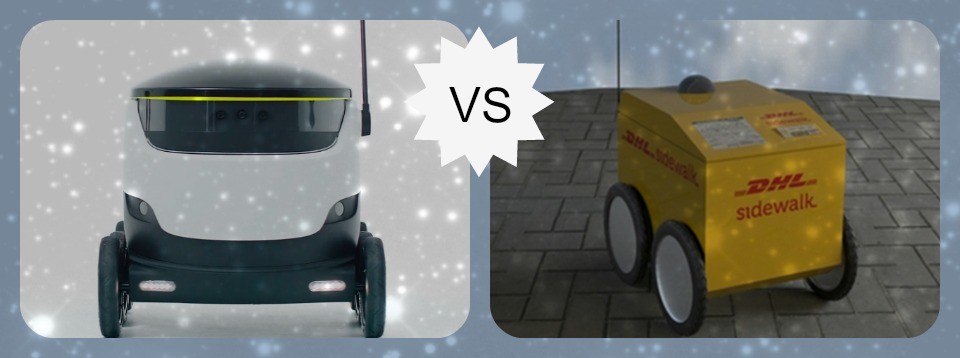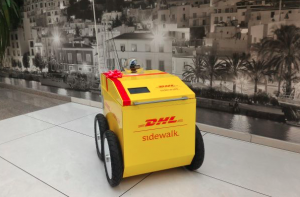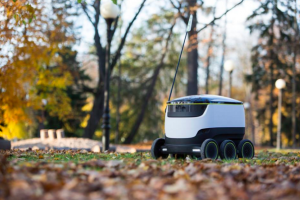Two robots-for-delivery startups from CEE bumped into me in the past few days. Meet Starship from Estonia and Sidewalk from Lithuania.
A new approach to last-mile delivery
Both projects are similar in terms of the problem they aim to solve, and in how they approach it.
They entrepreneurs want to optimize one of the key inefficiencies in logistics, which is the high cost (in terms of money and time) of the last mile in the delivery. In fact, you as a customer, who ordered a CD from Amazon, will get it delivered by a courier only a day or two after it’s been brought to your local delivery office. The self-driving delivery robots like Starship or Sidewalk want to take this “last mile” mission, and as soon as your goodsarrive to the hub, there are put and locked in the robot’s cargo. The robots, both Starship or Sidewalk, packed with a GPS module, cameras, and sensors, navigate in the streets at the same pace at pedestrians. The robots are connected to a mobile app, where the recipient can track the status of the delivery and eventually unlock the cargo. Also, both robots are tracked by human operators who are able to intervene and remotely control them.
Since Starship, thanks to their star founders, Ahti Heinla and Janus Friis, who are ex-founders of Skype {and faster communication with media}, got a great deal of coverage, we’ll start with their competitor.
Sidewalk was created by Superum company from Vilnius, founded by Roman Drokov, CEO, and Mangirdas Skripka, CTO. They just went through the Startup Sauna (Finland) accelerator program.
As for achievements, they already had their first pilot project with the local DHL branch (Lithuania), and, according to vceestartups, the plan is to expand the geography to Germany and Denmark.
The business model implies that Superum will be operating the robots, and selling their delivery services, not the robots themselves. The estimated cost of a delivery by Sidewalk is 2.99 euro. Also, the startup is planning to generate some income from placing ads on the robots. That might be a good idea for Starship as well since these “couriers” will be quite attention-grabbers (until we get delivery drones?!)
The founders also stress out that they are actively looking for partners and investors.
Estonian Starship looks sexier than Sidewalk, but the latter got twice as much muscle power and endurance. In fact, Sidewalk claims it can deliver up to 20 kg within a 10 km radius compared to 9 kg within 5 km stated by Starship Technologies.
According to Estonian World, Starship employs 30 people, with an R&D center in Tallinn, and an office in London. The pilot project will be launched next spring in Greenwich, a district in London, followed by the US, if all goes well.
I was particularly curious about two moments: if the robots can climb stairs, and how the operators will handle criminal situations. I’ve got my questions answered by Allan Martinson, the COO of Starship Technologies.
Starship robots are not intended to climb stairs (but they can climb curbstones). This platform is optimized for the suburban environment and the robots can drive up to the doorsteps.
Delivery robots security concerns
Allan says that they understand people’s concern regarding vandalism and theft. “However, we have not noticed any anomalous behaviour of thousands of people the robot has encountered during our initial field tests. If anything, they are positive and friendly,” he added. Also, there’s a mechanism to protect the robot:
- the cargo bay is firmly closed and can be unlocked only by the recipient,
- the robot transmits its location and condition to the operations centre in real time,
- the robot detects an attempt of vandalism or theft and will issue an alarm and notify the centre. Help will be under way in minutes,
- the robot has 9 live cameras, so the thief or vandal better smile broadly 😉
- “we have also some other aces in our sleeves that we don’t want to reveal too early”.
Another important argument is that Starships will rather carry lower-value, high-frequency, easily replaceable goods such as groceries. Plus, the robot itself has no value without being connected to the company’s servers. So, the risk of being caught is very high and the potential reward is low. Allan estimates that this risk shall not be significantly higher than vandalism or theft from cars, but they will take any such attempts very seriously and will make sure all criminals will get caught and prosecuted.















